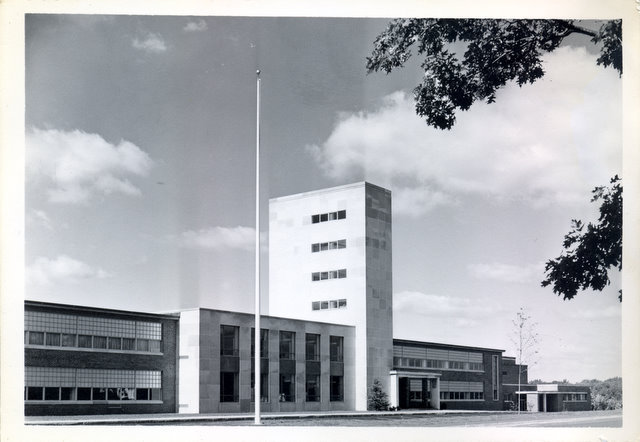Orange Lockers, Echo Hall, and A Bomb Shelter
Teachers Recall “Old” RMHS
From Reading Public Library resources: Cram, Arthur T., “Reading Memorial High School,” Reading Public Library, Reading, Mass., accessed November 19, 2020, https://digitalheritage.noblenet.org/reading/items/show/4411.
November 19, 2020
Today’s RMHS students don’t have a memory of the “old” RMHS building, but there are teachers on staff who can recall in detail the sprawling and quirky building that preceded our current home.
Since its original construction, the original building at 62 Oakland Road had fallen into disrepair over the years. It was about twice the size of the building today, but had a very strange layout. Many rooms were either too big or too small, and the hallways were either very wide or very narrow. Technology was extremely lacking, the classroom and labs were outdated, and the heating and cooling systems struggled as well.
I asked several teachers about some of their favorite memories from the old building and some interesting locations in the original layout that most students today would never have known.
Despite this, teachers have many memories of the old building that they hold dear to their hearts. Mr. DeBenedictis of the History Department describes some of the most interesting features of the old building that students today would most likely not know about. He said, “We had two gyms, two cafes, and our PAC had a balcony. We had a bomb shelter in the building from the Cold War. It was under the auditorium, and Drama stored all their sets and supplies there. There was Echo Hallway on the way to the shop rooms and the weight room. We had a woodshop and metal shop room. The old home economic room near echo hall had a bunch of ovens and cooking stations. There was the tower out front. It was divided into 3 buildings A-B-C. C is the current Social Studies/English/Foreign Language building. There was a vivarium on the top floor of C with animals, like snakes. Kids tried to hang out and meet at the ‘Orange Lockers’’ in between A-B-C. We had an interior, outdoor courtyard near the cafes.”
Ms. Lynn of the Science Department recalls one of her favorite memories from the old building. She said, “In the science wing of the old building there was a huge vivarium. It was, in essence, a big greenhouse with windows spanning the entire exterior wall from floor to ceiling. It was a fabulous space. In the summer, we had to paint the glass black to insulate the room and prevent the temperatures from getting too high. In addition to plants there were always interesting critters living there, too. Some residents over the years included turtles, snakes and an iguana.” She also mentions two interesting locations that gave RMHS its character at the time, saying “There was an area that was filled with orange lockers called ‘the bridge’. Also, there was a jukebox in the cafeteria for a while. Seniors could go there for studies and could listen to music and dance.”
Mr. Strout of the Technology Department also reminisces with one of his favorite memories of the old building. He said, “Spirit Week hall decorating was something from the old building that did not make it to the new building. Each grade got assigned to decorate a hallway of the school in whatever theme they chose. The freshmen and sophomores were never very good but the seniors and juniors always went all out and had great ideas.”
In the grand scheme of things, teachers were grateful for the updates to the school, despite distractions such as noise and construction workers. Ms. Lynn commented on the results of the construction saying, “It really lifted the spirits of the staff and students. Having beautiful lab spaces, surround sound, smart boards and white boards were significant improvements and allowed us to use better instructional strategies that utilized technology.” Mr. Strout added, “They made a huge change in the school. Everything was better and people cared about the building. The biggest impact was on technology. We barely had internet in the school; no smartboards, no projectors, and teachers did not have computers. We jumped from that to being one of the most advanced schools for technology.”
